Polish actress Soava Gallone (1880-1957) was directed in one silent film after another by her husband, Carmine Gallone. From the mid-1910s onwards, she appeared in more than 40 films between 1913 and 1931. The delicate diva starred in many Italian films as the 'femme fragile'.
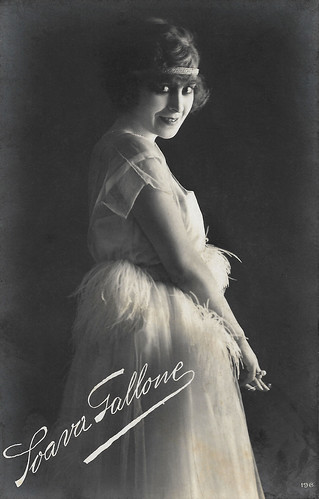
Italian postcard by Fotocelere, Torino, no. 196.
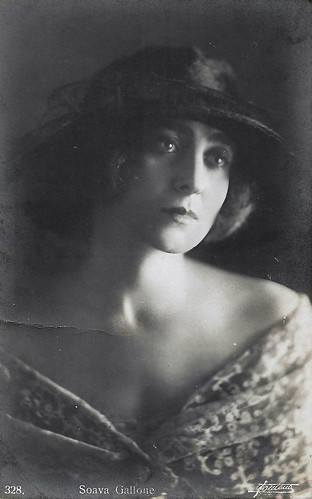
Italian postcard by Ed. A. Traldi, Milano, no. 328. Photo: Fontana.
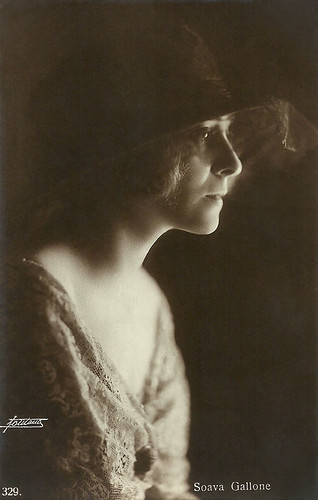
Italian postcard by Ed. A. Traldi, Milano, no. 329. Photo: Fontana, Roma.
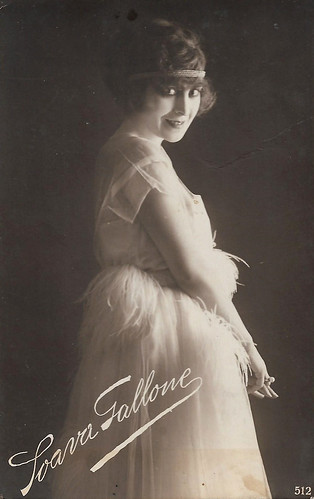
Italian postcard by Ed. A. Traldi, Milano, no. 512.
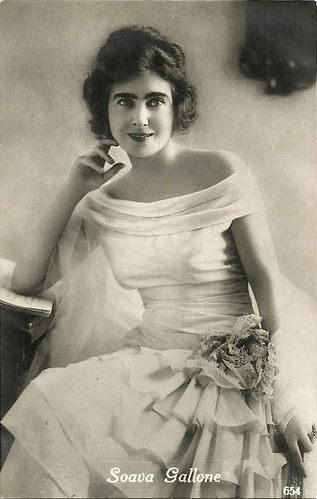
Italian postcard by Ed. A. Traldi, Milano, no. 654.
Soava Gallone was born Stanislawa Winawerówna in 1880 in Warsaw, Poland, then part of the Russian Empire. She left Poland for Italy, together with her mother and brother, to forget the bitterness of her previous marriage. In Sorrento, Stanislawa, now known as Soave, met a young man with high hopes: Carmine Gallone. While he wrote her poems, she hoped to perform in his stage plays. The two married in 1911 and left for Rome. Their start was not a success, as Gallone’s 'Coriolano' was not well received.
Soava was a stunning beauty but lacked correct Italian diction, so the two started to work at the Cines film company. In 1913, she appeared together with her husband in the films Il romanzo/The Romance by Nino Martoglio, and the drama I corvi/The Crows. In 1914, Carmine Callone became a film director and started to direct his wife in his films. Their first feature was the comedy Il bel gesto/The Nice Gesture (Carmine Gallone, 1914) for the Società Italiana Cines.
The couple managed to shoot a series of films, set on their beloved coast around Amalfi, Sorrento and Capri. Soava played the fiancee of a sailor, a fisherman, a coastguard, a pirate etc., all with the local scenery as an asset. Cines exported these films which international critics praised for their scenic beauty. However, the films didn’t become box-office hits in Italy. In 1914, Soava Gallone also started a stage career, which explains why she did not appear in many films in the years 1915 and 1916. In the theatre, she worked with the new company of the Teatro Manzoni of Milan, led by Marco Praga.
In 1916, she finally became a big success in her own country, both critically and in audience response with Avatar/The Magician (Carmine Gallone, 1916) with André Habay, and subsequently with La chiamavano Cosetta/They Call Her Cosetta (Eugenio Perego, 1917), which was specially written for Soava by Lucio D’Ambra. A copy of La chiamavano Cosetta/They Call Her Cosetta has been traced by the film archive of Bologna but still waits for restoration.
The dramatic story of La chiamavano Cosetta is about the writer Marco (Amleto Novelli), deluded by his rich girlfriend, who dreams of being Pygmalion. He meets his Galatea when he sees Cosetta (Soava), a wild girl from the woods, and makes her his model, becoming a sculptor himself. Matters run out of hand when Soava falls in love with Marco, who still loves his old girlfriend, while instead Marco’s son loves Cosetta and kills himself out of love for her when she refuses him. The devastated father kills his model with the marble.

Italian postcard, printed by Alfieri & Lacroix, Milano. Publicity by Cinema Teatro Dante for the film La storia di un peccato/The Story of a Sin (Carmine Gallone, Films d'Eccezione 1918). The rights of the film were with Ligure Films for the regions Piemonte and Liguria. This card may refer to a Cinema Dante at Savona, as the company Ligure Films was based here. Still, it could also refer to a Cinema Dante of Milan, although the only one hitherto known opened in 1925. On the card, the film is indicated as Storia di un peccato.

Italian postcard. Photo: Unione Cinematografico Italiana - Palatino Film. Soava Gallone in Marcella/Mother Love (Carmine Gallone, Celio Films 1921). Caption: Marcella can finally embrace her son again. The other woman may well be Fulvia Perini, playing Marcella's aunt.

Italian postcard by G.B. Falci, Milano. Photo: Films Gallone. Publicity still of Soava Gallone and Marcella Sabbatini in All'ombra di un trono/In the Shadow of a Throne (Carmine Gallone, 1921). Other actors were Umberto Casilini and Piero Schiavazzi. The film was based on a novel by Charles Folly, 'Fleur d'ombre'.
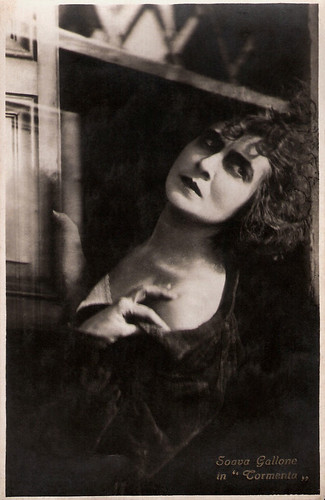
Italian postcard by G.B. Falci Editori, Milano / La Fotominio, no. 71. Photo: Soava Gallone in La Tormenta/The Storm (Carmine Gallone, 1922).

Italian postcard. Photo: A.P. Film. Publicity still of Soava Gallone and Gustavo Serena in La via del peccato/The Way of Sin (Amleto Palermi, 1925).

Italian postcard by Ed. A. Traldi, Milano. Photo: Westi / SAIC. Soava Gallone in the historical film La Cavalcata Ardente/The Fiery Cavalcade (Carmine Gallone, 1925).
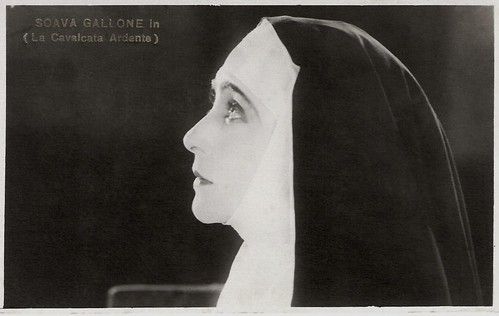
Italian Postcard by G.B. Falci Editori, Milano. Photo: still from La Cavalcata Ardente/The Fiery Cavalcade (Carmine Gallone, 1925).

Italian postcard. Caricature by Sandro Properzi for Le Maschere, Rome.
Carmine Gallone had the intelligence to pick films that fully sustained the image of Soava Gallone as a refined, delicate soul. He limited her performances to no more than two per year. Among her best films are La storia di un peccato/The Story of a Sin (1918), and in particular Madame Poupée/A Doll Wife (1919), based on an original script by Washington Borg. In the latter Soava plays a young mother whose happiness is destroyed by the evil scheming of a rival. The film offers a touching and delicate portrait by Gallone as 'femme fragile'.
For D'Ambra Film she appeared in the drama Il bacio di Cirano/Cyrano's Kiss (Carmine Gallone, 1919), written by Lucio D'Ambra. Memorable as well are Amleto e il suo clown/On with the Motley (1920) and especially La Cavalcata Ardente/The Fiery Cavalcade (Carmine Gallone, 1925). This highly successful melodrama was set against the background of the conquest of Naples by Garibaldi's volunteers.
In La cavalcata ardente, Soava plays an aristocrat who is forced into marriage with an old prince (Emilio Ghione), but secretly, she is in love with a patriot (Gabriel de Gravone). Masked, the lover leads a cavalry to save the girl during the betrothal party (hence the arduous cavalcade of the title), which leads to the girl hiding in a convent and the lover reaching for the troupes of Garibaldi. He is arrested, however, and the girl can only save his life by accepting marriage with the old prince. For the second time she is saved, however, when Garibaldi’s troupes are before Naples, the old prince dies in the following fight, and the two lovers are finally reunited.
The crisis in Italian cinema in the late 1920s forced Soava and Carmine Gallone to work abroad. Carmine worked in France, Germany and the United Kingdom, but Soava only played in one final silent film in France, Celle qui domine/Crossroad of Love (1927), which her husband co-directed with French director Léon Mathot, who also played the lead.
In 1930, Soava Gallone played in an early sound film, Il segreto del dottore/The Doctor's Secret (1931), directed by Jack Salvatori and shot at the Paramount Studios near Paris. It was her last film. While her husband pursued a successful career in sound cinema, Soava Gallone remained a star from the silent era. She died in 1957 in Rome, Italy, at the age of 77.

Italian postcard, no. 117. Photo: Bettini, Roma.
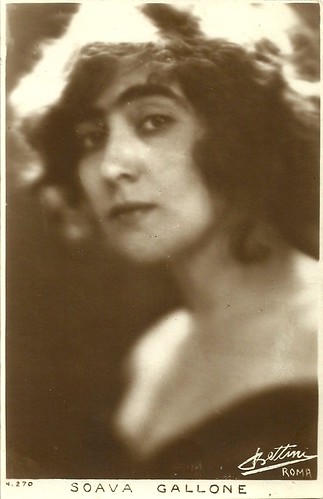
Italian postcard, no. 270. Photo Bettini, Roma.

Italian postcard. Editor and photographer unknown.
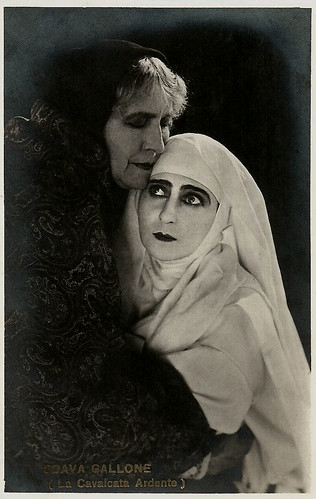
Italian postcard by G.B. Falci Editori, Milano. Photo: still from La Cavalcata Ardente/The Fiery Cavalcade (Carmine Gallone, 1925) with Jeanne Brindeau.
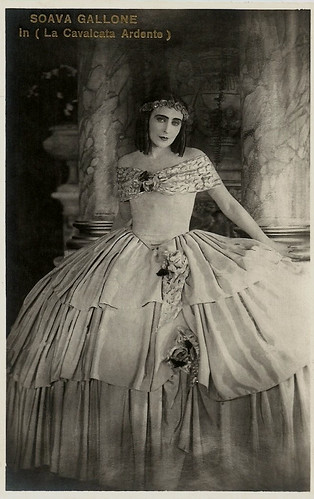
Italian postcard by G.B. Falci, Milano. Photo: publicity still for La Cavalcata Ardente/The Fiery Cavalcade (Carmine Gallone, 1925).

Italian postcard by Fotocelere, no. 219.

Italian postcard by Editions Cinemagazine, Paris, no. 357.
Sources: Aldo Bernardini (Cinema muto Italiano - Protagonisti - Italian), Vittorio Martinelli (Le dive del silenzio), Vittorio Martinelli (Il cinema muto italiano), Wikipedia and IMDb.
This post was last updated on 31 May 2024.

Italian postcard by Fotocelere, Torino, no. 196.

Italian postcard by Ed. A. Traldi, Milano, no. 328. Photo: Fontana.

Italian postcard by Ed. A. Traldi, Milano, no. 329. Photo: Fontana, Roma.

Italian postcard by Ed. A. Traldi, Milano, no. 512.

Italian postcard by Ed. A. Traldi, Milano, no. 654.
A wild girl from the woods
Soava Gallone was born Stanislawa Winawerówna in 1880 in Warsaw, Poland, then part of the Russian Empire. She left Poland for Italy, together with her mother and brother, to forget the bitterness of her previous marriage. In Sorrento, Stanislawa, now known as Soave, met a young man with high hopes: Carmine Gallone. While he wrote her poems, she hoped to perform in his stage plays. The two married in 1911 and left for Rome. Their start was not a success, as Gallone’s 'Coriolano' was not well received.
Soava was a stunning beauty but lacked correct Italian diction, so the two started to work at the Cines film company. In 1913, she appeared together with her husband in the films Il romanzo/The Romance by Nino Martoglio, and the drama I corvi/The Crows. In 1914, Carmine Callone became a film director and started to direct his wife in his films. Their first feature was the comedy Il bel gesto/The Nice Gesture (Carmine Gallone, 1914) for the Società Italiana Cines.
The couple managed to shoot a series of films, set on their beloved coast around Amalfi, Sorrento and Capri. Soava played the fiancee of a sailor, a fisherman, a coastguard, a pirate etc., all with the local scenery as an asset. Cines exported these films which international critics praised for their scenic beauty. However, the films didn’t become box-office hits in Italy. In 1914, Soava Gallone also started a stage career, which explains why she did not appear in many films in the years 1915 and 1916. In the theatre, she worked with the new company of the Teatro Manzoni of Milan, led by Marco Praga.
In 1916, she finally became a big success in her own country, both critically and in audience response with Avatar/The Magician (Carmine Gallone, 1916) with André Habay, and subsequently with La chiamavano Cosetta/They Call Her Cosetta (Eugenio Perego, 1917), which was specially written for Soava by Lucio D’Ambra. A copy of La chiamavano Cosetta/They Call Her Cosetta has been traced by the film archive of Bologna but still waits for restoration.
The dramatic story of La chiamavano Cosetta is about the writer Marco (Amleto Novelli), deluded by his rich girlfriend, who dreams of being Pygmalion. He meets his Galatea when he sees Cosetta (Soava), a wild girl from the woods, and makes her his model, becoming a sculptor himself. Matters run out of hand when Soava falls in love with Marco, who still loves his old girlfriend, while instead Marco’s son loves Cosetta and kills himself out of love for her when she refuses him. The devastated father kills his model with the marble.

Italian postcard, printed by Alfieri & Lacroix, Milano. Publicity by Cinema Teatro Dante for the film La storia di un peccato/The Story of a Sin (Carmine Gallone, Films d'Eccezione 1918). The rights of the film were with Ligure Films for the regions Piemonte and Liguria. This card may refer to a Cinema Dante at Savona, as the company Ligure Films was based here. Still, it could also refer to a Cinema Dante of Milan, although the only one hitherto known opened in 1925. On the card, the film is indicated as Storia di un peccato.

Italian postcard. Photo: Unione Cinematografico Italiana - Palatino Film. Soava Gallone in Marcella/Mother Love (Carmine Gallone, Celio Films 1921). Caption: Marcella can finally embrace her son again. The other woman may well be Fulvia Perini, playing Marcella's aunt.

Italian postcard by G.B. Falci, Milano. Photo: Films Gallone. Publicity still of Soava Gallone and Marcella Sabbatini in All'ombra di un trono/In the Shadow of a Throne (Carmine Gallone, 1921). Other actors were Umberto Casilini and Piero Schiavazzi. The film was based on a novel by Charles Folly, 'Fleur d'ombre'.

Italian postcard by G.B. Falci Editori, Milano / La Fotominio, no. 71. Photo: Soava Gallone in La Tormenta/The Storm (Carmine Gallone, 1922).

Italian postcard. Photo: A.P. Film. Publicity still of Soava Gallone and Gustavo Serena in La via del peccato/The Way of Sin (Amleto Palermi, 1925).

Italian postcard by Ed. A. Traldi, Milano. Photo: Westi / SAIC. Soava Gallone in the historical film La Cavalcata Ardente/The Fiery Cavalcade (Carmine Gallone, 1925).

Italian Postcard by G.B. Falci Editori, Milano. Photo: still from La Cavalcata Ardente/The Fiery Cavalcade (Carmine Gallone, 1925).

Italian postcard. Caricature by Sandro Properzi for Le Maschere, Rome.
Femme fragile
Carmine Gallone had the intelligence to pick films that fully sustained the image of Soava Gallone as a refined, delicate soul. He limited her performances to no more than two per year. Among her best films are La storia di un peccato/The Story of a Sin (1918), and in particular Madame Poupée/A Doll Wife (1919), based on an original script by Washington Borg. In the latter Soava plays a young mother whose happiness is destroyed by the evil scheming of a rival. The film offers a touching and delicate portrait by Gallone as 'femme fragile'.
For D'Ambra Film she appeared in the drama Il bacio di Cirano/Cyrano's Kiss (Carmine Gallone, 1919), written by Lucio D'Ambra. Memorable as well are Amleto e il suo clown/On with the Motley (1920) and especially La Cavalcata Ardente/The Fiery Cavalcade (Carmine Gallone, 1925). This highly successful melodrama was set against the background of the conquest of Naples by Garibaldi's volunteers.
In La cavalcata ardente, Soava plays an aristocrat who is forced into marriage with an old prince (Emilio Ghione), but secretly, she is in love with a patriot (Gabriel de Gravone). Masked, the lover leads a cavalry to save the girl during the betrothal party (hence the arduous cavalcade of the title), which leads to the girl hiding in a convent and the lover reaching for the troupes of Garibaldi. He is arrested, however, and the girl can only save his life by accepting marriage with the old prince. For the second time she is saved, however, when Garibaldi’s troupes are before Naples, the old prince dies in the following fight, and the two lovers are finally reunited.
The crisis in Italian cinema in the late 1920s forced Soava and Carmine Gallone to work abroad. Carmine worked in France, Germany and the United Kingdom, but Soava only played in one final silent film in France, Celle qui domine/Crossroad of Love (1927), which her husband co-directed with French director Léon Mathot, who also played the lead.
In 1930, Soava Gallone played in an early sound film, Il segreto del dottore/The Doctor's Secret (1931), directed by Jack Salvatori and shot at the Paramount Studios near Paris. It was her last film. While her husband pursued a successful career in sound cinema, Soava Gallone remained a star from the silent era. She died in 1957 in Rome, Italy, at the age of 77.

Italian postcard, no. 117. Photo: Bettini, Roma.

Italian postcard, no. 270. Photo Bettini, Roma.

Italian postcard. Editor and photographer unknown.

Italian postcard by G.B. Falci Editori, Milano. Photo: still from La Cavalcata Ardente/The Fiery Cavalcade (Carmine Gallone, 1925) with Jeanne Brindeau.

Italian postcard by G.B. Falci, Milano. Photo: publicity still for La Cavalcata Ardente/The Fiery Cavalcade (Carmine Gallone, 1925).

Italian postcard by Fotocelere, no. 219.

Italian postcard by Editions Cinemagazine, Paris, no. 357.
Sources: Aldo Bernardini (Cinema muto Italiano - Protagonisti - Italian), Vittorio Martinelli (Le dive del silenzio), Vittorio Martinelli (Il cinema muto italiano), Wikipedia and IMDb.
This post was last updated on 31 May 2024.
1 comment:
I just adore this post. Wow! Those photos are just extraordinary. Thank you for all the research you do. It's just fascinating.
Post a Comment